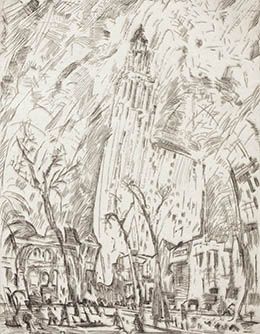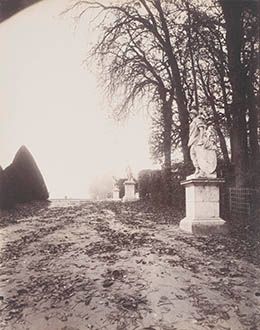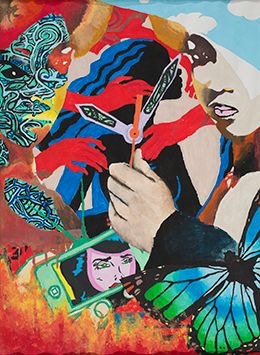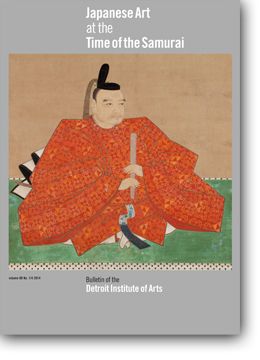|
|
 Director's Letter Director's Letter
 | |
With the opening of Samurai: Beyond the Sword, we can finally present more than a fraction of our East Asian collections, at least the Japanese portion and at least for a few months. When we opened the "New DIA" in late 2007, we had postponed the presentation of our Asian material as the result of two common factors: time and money. Construction and conditioning the galleries was not completed until a short while before the scheduled opening, the budget no longer had the wherewithal to cover the expensive casework required for most of our Asian art objects, and we were without a curator for East, South, and Southeast Asian art. Finally leaving the Asian galleries incomplete, rather than any other areas, created fewer way-finding and safety issues. When we were able to begin addressing Asian art, the head of the department of Asian and Islamic art was an Islamicist, and it made more sense to focus on the Islamic section--particularly in light of the significant Middle Eastern community in Southeast Michigan. With financial support from the Rosemarie and Ernest Kanzler Foundation, the display of the Islamic collection opened to the public in February 2009. Any further work on the galleries was severely impeded by the massive budget cuts the following month and the uncertainty of the DIA's position in the years leading up to the successful millage vote.
In January 2010, Birgitta Augustin joined the DIA's curatorial staff as associate curator of Asian art and acting head of the department of The Arts of Asia and the Islamic World. A specialist in Chinese painting, she also has considerable expertise in Japanese art and immediately became involved in the planning for the Samurai show. In addition, she added a number of significant works to the Japanese collection; most, if not all, can be seen in the current exhibition (look for a recent date at the beginning of the DIA number at the bottom of each label). Despite the DIA's latest crisis, research and work on the reinstallation of the Chinese and other Asian collections, representing some of the world's oldest continuous civilizations, and the Ancient Middle East collection, has begun. No dates have been set for the opening of these galleries, and we are currently in the process of seeking funding.
Unlike many of our collections, the Asian ones have neither depth nor breadth but have been characterized by specialists as being small holdings that have a high quotient of superb pieces. Last year, when I was browsing in the bookstore of the Asian Art Museum in San Francisco, the cover image on Karen Armstrong's recent book on Buddha looked familiar. I picked it up to find it was our very own masterpiece--a Korean Head of Buddha, dating from around 800. You can see it, along with a small group of works representing these long-lived cultures, in the two northernmost spaces at the end of the central promenade corridor.

Graham W. J. Beal
Back to top |
|

Exhibitions
 Samurai Samurai
Beyond the Sword
Through June 1
Special Exhibition Galleries: South
To present a nuanced view of the samurai, DIA Associate Curator of Asian Art Birgitta Augustin knew she had to go beyond the stereotypical portrayal of a mighty warrior and explore the cultural accomplishments of these iconic figures. She did so by adding Japanese works of art, mostly from the DIA's permanent collection, to the traveling exhibition Lethal Beauty: Samurai Weapons and Armor.
Samurai underwent rigorous training in the military arts (bu)--swords and suits of armor--and the cultural arts (bun), represented by tea ceremony objects, painted screens, vivid prints, Noh theater costumes, and the literary arts. Among the large folding screens included in the exhibition are the nineteenth-century glowing, paint-on-gilded silk Reeds and Cranes and the seventeenth-century, gold and colors on paper Reeds and Geese, a combination that Detroit News critic Michael Hodges called a "glorious juxtaposition." He went on to say that the DIA's screen illustrating a chapter of The Tale of Genji was "so vivid you can practically smell the scent of cherry blossoms."
Reeds and Cranes and The Tale of Genji are among the five objects Augustin picked as among her favorites drawn from the DIA permanent collection. Click here to see what the others are.
Members see the exhibition free but reservations for complimentary timed tickets are necessary. A special members' only evening is scheduled for Tuesday, April 22, from 4 to 9 p.m. Tickets for the members' evening and all other times are available by calling the Membership Helpline, 313.833.7971, or online. There are no handling charges when ordering member tickets.
Tickets for the general public are $16 for adults and $8 for ages 6-17. Group tickets (15+) are $12 per ticket. Purchase at the DIA Box Office, dia.org, or 313.833.4005. A $3.50 charge applies to nonmember tickets not purchased at the DIA. Tickets are timed, and advance purchase is recommended.
Above: Reeds and Cranes, 1800s, ink and gold on silk; Suzuki Kiitsu, Japanese. Founders Society Purchase with funds from the Gerald W. Chamberlin Foundation, Inc.,Mr. and Mrs. Charles M. Endicott, Mrs. Howard J. Stoddard, Mr. Howard P. Stoddard, and Mr. and Mrs. Stanford Stoddard
This exhibition is organized by the Detroit Institute of Arts, based on the original exhibition Lethal Beauty, curated by Dr. Andreas Marks for the Clark Center for Japanese Art and Culture, with tour organized by International Arts & Artists, Washington, DC.
In Detroit, the exhibition is generously supported by Toyota, DENSO International America, Inc., E. Rhodes and Leona B. Carpenter Foundation, and Yazaki North America, Inc.
 
  
Back to top
 Let Me Show You What I Saw Let Me Show You What I Saw
American Views on City and Country, 1912-1963
Schwartz Galleries of Prints and Drawings
Through June 29
 | | |
Woolworth Building, 1913, etching; John Marin, American. Founders Society Purchase, Elizabeth P. Kirby Fund
| |
John Marin is one of three artists--Charles Burchfield and Martin Lewis being the other two--whose work forms the core of this exhibition. Unlike Burchfield, Lewis, and many other artists who specialized in either city or country views, Marin made prints and drawings of both. Using bold brushwork and vibrant color, he conveyed the spirit of rural locations as different as the New England coast and American southwest. With very fluid and dark watercolors, he captured the mood of a rainy Maine vista from a position out in the ocean looking back to the shore in Green Head, Deer Island. A deep, strong turquoise not only enlivens his mountainous panorama New Mexican Landscape near Taos but also refers to the characteristic color and minerals found in the desert.
Marin's etchings of New York City, from the 1910s and later, pulsate with the energy of the new urban scene; short, fractured lines serve as a perfect visual symbol to echo the beat of the burgeoning city. His 1913 depiction of the Woolworth Building, then one of the tallest in the world, is lyric; the skyscraper appears to sway to the lively rhythm of life. This print and others of the Brooklyn Bridge, Fifth Avenue, and the el trains not only celebrate the optimism of the modern world, but they also mark Marin as one of the first American artists to begin working in avant-garde, abstract styles.
Marin was born and trained on the East Coast but lived in Europe from 1905 to 1911. He travelled extensively, including trips to France, England, Italy, Germany, and Russia, where his interest in portraying the dynamism underlying so much of early twentieth-century culture was echoed by artists everywhere. His use of broken dashes and lines in his own work owes much to the interpretive investigations of Pablo Picasso and Georges Braque into what would become cubism. Marin was one of the major organizers of the 1913 Amory Show, which brought examples of these new visual theories to the American public for the first time.
This exhibition, organized by the Detroit Institute of Arts, is free with museum admission.
Back to top
 Foto Europa Foto Europa
1850 to the Present
Albert and Peggy de Salle Gallery of Photography
Through April 27
 | | |
Versailles-Allée des Trois Fontaines (Versailles-Path with Three Fountains), about 1906, gold chloride print; Eugène Atget, French. Founders Society Purchase, K.T. Keller Fund
| |
Only a few weeks remain to see this exhibition tracing the development of photography as an art form in Europe from the medium's earliest days through contemporary times. From the start, European artists demonstrated photography's ability to enhance viewers' awareness of human experience, to broaden perceptions of eras and civilizations, past and present, and to question reality at large.
Nineteenth-century French and British photographers were the first to take on portraiture and landscape, as represented by rare daguerreotypes and other early historical photographic processes. Between the World Wars, experimentation flourished, characterized by photographs with dramatic viewpoints, darkroom manipulation, and abstraction. Photographers also took to the streets to capture the unexpected moments found in the theater of life.
The contemporary section juxtaposes the works of artists with a commitment to the objective nature of photography with those who both question and challenge that particular view. A separate section features European photographers' take on the city of Detroit.
This exhibition, organized by the Detroit Institute of Arts, is free with museum admission.
Back to top
 Detroit Public Schools Student Exhibition Detroit Public Schools Student Exhibition
Walter Gibbs Gallery, Wayne and Joan Webber Education Wing
April 12-June 8
 | | |
Keepers of the Dreams, 2014, painting; Justin Coleman, Davis Aerospace High School, Grade 9.
| |
More than 400 imaginative works of art created by Detroit Public Schools students are on view in and around the Gibbs Center gallery for the Seventy-seventh Annual Detroit Public Schools Student Exhibition, which opens this month. Kindergarteners through high school students from twenty-six schools submitted paintings, prints, drawings, photography, ceramics, videos, jewelry, and other types of work to a jury of local artists, school officials, and a DIA representative to determine what to include in the exhibit.
The Seventy-seventh Annual Detroit Public Schools Student Exhibition was organized by the Detroit Institute of Arts and the Detroit Public Schools and is made possible with support from the Ruth T. T. Cattell Education Endowment Fund. Additional support was provided by the Detroit Public Schools Foundation.
Back to top |
|
 Detroit Film Theatre Detroit Film Theatre
Samurai come to the DFT this month in the form of four classic Japanese films that explore the warrior class and its culture. The films are shown in conjunction with the exhibition Samurai: Beyond the Sword. With the exception of the April 18 film, which is silent, the movies are in Japanese with English subtitles.
 | | |
A scene from 13 Assassins, a Magnet Release. Photo courtesy of Magnet Releasing.
| |
The Sword of Doom is first on the schedule, playing on Saturday, April 5, at 3 p.m. Set in the 1860s, the merciless behavior of an outcast samurai leaves the warrior little choice other than to make his living as a paid assassin. 13 Assassins, showing April 12 at 3 p.m., tells the story of a group of unemployed samurai at the end of the feudal era who are recruited to bring down a sadistic lord and prevent him from ascending to the throne.
The silent A Story of Floating Weeds follows an aging, traveling actor's return to a small town, where he reunites with his former lover and their illegitimate son. The film is accompanied by Alex de Grassi on acoustic guitar. The movie plays Friday, April 18, at 7 p.m. and is free with museum admission.
Yojimbo is the story of a master-less samurai who wanders into a village terrorized by two equally evil factions. He turns the situation to his advantage by secretly selling his services to both sides. Akira Kurosawa's pioneering blend of violence and wit was subsequently remade as A Fistful of Dollars. The film shows Saturday, April 19, at 3 p.m.
The last of this season's Saturday Animation Club matinees is Howl's Moving Castle, the tale of teenage shop girl Sophie, who meets a handsome but mysterious wizard named Howl and is subsequently turned into the ninety-year-old Witch of the Waste. The English language version of the film runs Saturday, April 26, at 3 p.m.
For a complete schedule, click here.
The DFT is presented by Buddy's Pizza.

Back to top |
|
 Samurai: Beyond the Exhibition Samurai: Beyond the Exhibition
In addition to the current special exhibition and DFT films, samurai can be found in a new publication, in the museum shop, and on the runway.
A special issue of the Bulletin of the Detroit Institute of Arts, published in conjunction with Samurai: Beyond the Sword looks at Japanese works in the DIA permanent collection as representative of the samurai's truly long-lasting achievements in the arts. The ten essays by authors from Japan and the United States illuminate how the cultural activities of the samurai are an essential part of understanding Japan's long history of the intersections between military and artistic lives. The Bulletin will be available in the museum shop later this month. The catalogue for the traveling exhibition Lethal Beauty is also available.
The museum's Samurai exhibition shop features a large assortment of Japanese home goods, jewelry, books, and toys. Pack a lunch in a Samurai Bento Box, a little ninja (in male and female versions) that has two separate sections, one with a lid, plus a bowl for soup. Jubako, Japanese stacking boxes, are used during festivals to serve traditional foods but double as jewelry or keepsake boxes, too. And, with Earth Day just around the corner (April 22), the shop offers some eco-friendly products, including the Kwytza baskets made from recycled chopsticks.
The Samurai Shop is located on the second floor of the museum and can be accessed either from outside the exhibition (no tickets required) or as you exit the exhibition space. Of course, you can shop online, anytime, at diashop.org.
Ten local fashion designers put their talents to the test in "Beyond the Armor," a competition to create an outfit based on artworks in the Samurai exhibition. Completed ensembles will be on display at three locations: Henry Ford West Bloomfield Hospital, 6777 W. Maple Road, West Bloomfield, April 21-27; Warren Community Center, 5460 Arden Rd., Warren, April 28-May 4; and a yet-to-be determined Canton location, May 5-12. The viewing public determines the winner by voting for their favorite outfit at any of the three venues, or online, beginning April 21. The winning design will be announced at a fashion show at the DIA on Saturday, May 17, at noon. In the meantime, read blog posts by the designers about their work. The competition was a collaborated effort by the DIA and the Detroit Garment Group Guild.
Back to top |
|
 Chess Anyone? Chess Anyone?
You never know who might show up at the Detroit City Chess Club's Friday night practice sessions at the DIA. Third-grader Charisse Woods said she felt nervous playing Detroit Mayor Mike Duggan, but she was happy to meet him during their January 25 showdown, which ended in a draw. "I'd say he was on my level, but may have been a little better," she added. The mayor asked for a rematch, but he may need to sharpen his skills. Charisse, an eight-year-old third grader at Chrysler School was named top player in her age group at a recent regional tournament in Cincinnati.
Charisse and other chess club members were awarded the 2014 primary and elementary team championships at the Michigan Chess Association statewide competition in February, a tournament that included ninety-five teams from fifty schools. Chess club members, kindergarteners to twelfth-graders from across Metro Detroit, practice Fridays nights at the DIA. People wanting to learn how to play the game can show up between 4 and 6 p.m. There will be no teaching between 6 and 8 p.m., but visitors can play chess.
Back to top |
|
 News and Notes News and Notes
Must See
Fodors Travel, a website from the publisher of guidebooks, has named the DIA one of the twenty must-see art museums in the United States. The DIA is thirteenth on the list (the Metropolitan Museum of Art in New York is number one). When reposted on our Facebook page, it was "liked" by more than 1,700 people, well above the usual 100 to 500 likes. (Our most popular post was a picture of the Woodward doors with the "thank you" decals after the millage passed, which received over 11,000 likes.)
And what did visitors to our repost have to say? "DIA a Must-See? Hell, we knew that!" "No surprise here!! World class all the way; the DIA can hold its head up high with all the top museums in this country and overseas!" "The DIA is a 'must see" the way that the DSO is a "must hear." And finally, "Please. Top 10."
Environmental Tours
The DIA has teamed up with Detroiters Working for Environmental Justice and its Detroit Climate Action Collaborative for a pilot program that allows students to study human relationships with the environment and natural resources through art and art making. In January, students from Samuel Gompers Elementary-Middle School and the Detroit Institute of Technology College Prep High School at Cody High School toured environmentally themed works from the collection, including American landscapes, Native American textiles, and contemporary sculpture, that fostered discussions about the connections among art, land, water, atmosphere, and humans. Once a week during March, the students created art inspired by their tours and discussions in the DIA's studio. Their works are on view with the Seventy-seventh Annual Detroit Public Schools Student Exhibition, opening April 12.
The tour is a prototype and the museum hopes to offer it as part of a school field trip experience next year.
Spring Break Drop-ins: Musical Instruments
Looking for something different to do with kids over spring break? Check out the special musical instrument drop-in workshops offered at the DIA Tuesday, April 22 through Friday, April 25, from 11 a.m. to 3 p.m. A different instrument is featured each day: Tuesday, it's sistrums, sacred rattles from ancient Egypt; Wednesday. the West African kalimba; Thursday, rattles large and small; and finishing up on Friday with tambourines. Drop-ins are free with museum admission. No advanced registration needed.
County Days
Wayne County residents can park and leave the driving to us for a DIA visit on Saturday, April 5. Free bus transportation to and from the museum is available at numerous locations around the county. Visitors can browse the collection, take part in an art-making activity, view two free exhibitions, or see the Samurai: Beyond the Sword exhibition at the discounted group rate of $12 per person.
Buses depart from the park-and-ride locations at 9:30 or 10 a.m. and leave the museum for the return trip at 2 or 2:30 p.m. The bus trip is free, but reservations are required. For departure locations, schedule information, and to reserve a spot, call 313.833.4005 or click here.
Back to top |
|
|
|
|
|
Detroit Institute of Arts
5200 Woodward Avenue
Detroit, Michigan 48202
www.dia.org
313.833.7900
Comments or questions about the newsletter? Please contact us: comments@dia.org
ADMISSION
$8 adults, $6 seniors, $4 children
The museum is free for members and residents of Wayne, Oakland, and Macomb Counties
Contact the Membership HelpLine at
313.833.7971 or membership@dia.org
For group sales (15 or more) contact 313.833.1292 or dia.org/grouptours
|
HOURS
Museum
Mon CLOSED
Tue, Wed, Thur 9 a.m.-4 p.m.
Fri 9 a.m.-10 p.m.
Sat, Sun 10 a.m.-5 p.m.
PARKING
Valet parking is $10 per car and available at the Woodward entrance Friday through Sunday during museum hours.
Lighted, secure self-parking is available in the Cultural Center parking lot, between John R and Brush, behind the museum.
|
CaféDIA
313.833.7966
Tue, Wed, Thur 11:30 a.m.-2:30 p.m.
Fri 11 a.m.-2:30 p.m., 4-9 p.m.
Sat, Sun 11 a.m.-3 p.m.
Kresge Court
Tue, Wed, Thur 9 a.m.-3:30 p.m.
Fri 9 a.m.-9:30 p.m.
Sat., Sun 10 a.m.-4:30 p.m.
Museum Shop
313.833.7944 or museumshop@dia.org
Open during museum hours or online at diashop.org
|
|
|
|
|
|

















